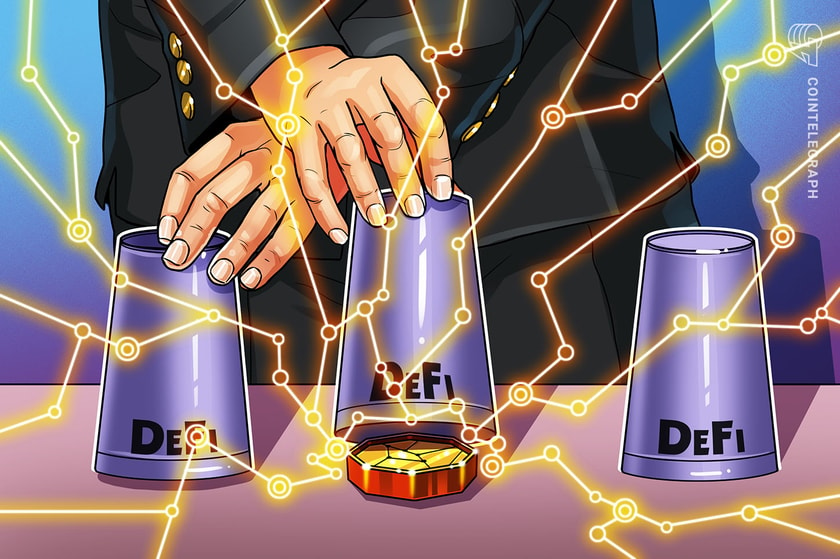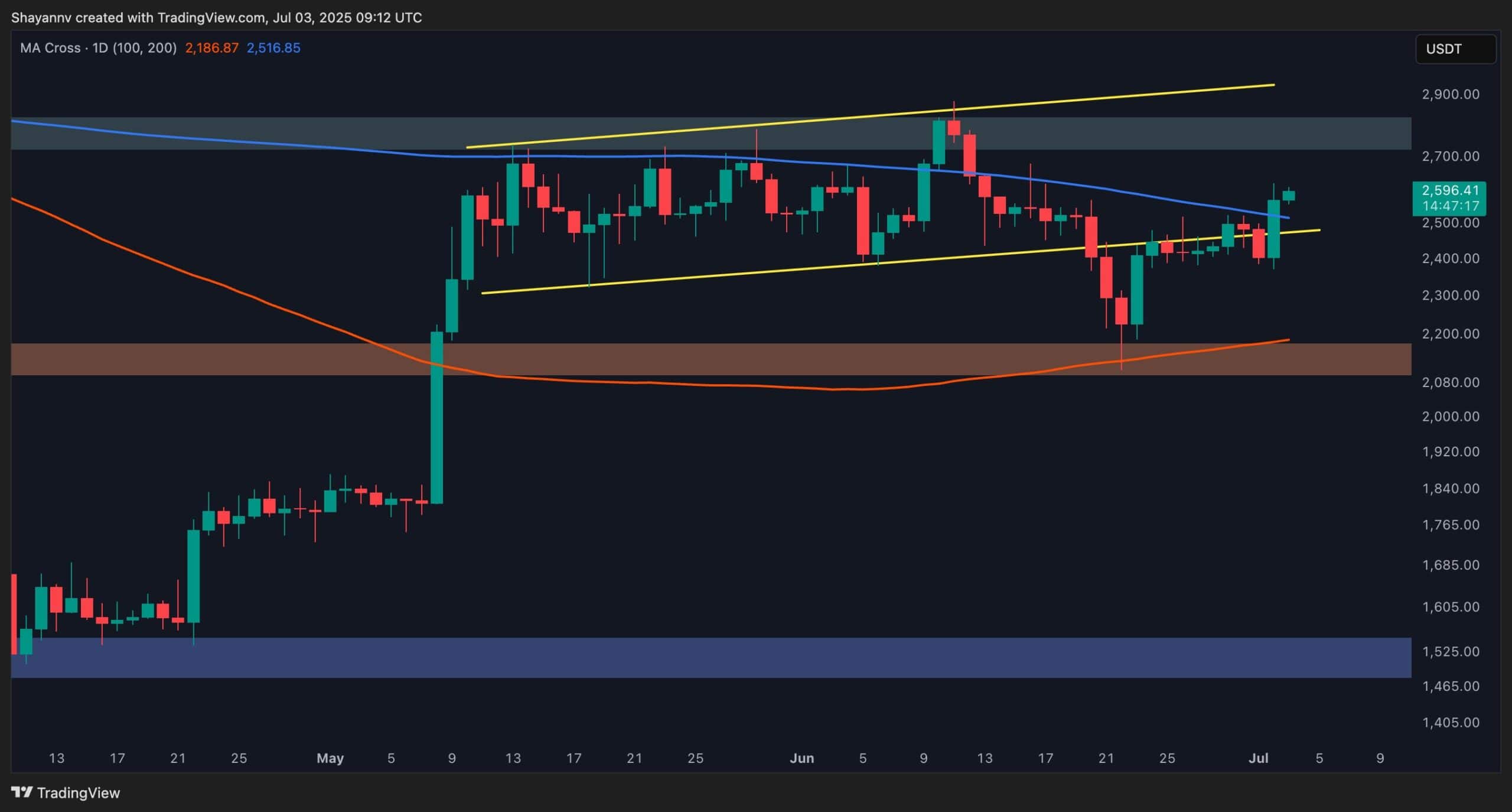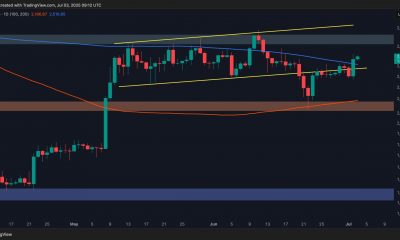Cryptocurrency
DeFi as a solution in times of crisis

The 2020s have been a challenging decade so far, yet the transformative power of blockchain technology offers a better path forward.
Born from crisis
Around the globe, times are tough for many everyday people. Increases in cost of living minimized any growth in wages last year as inflation continues to take its toll. Additionally, world powers such as China and Russia are increasingly challenging the dominance of the USD as geopolitical tensions flare up.
In this precarious new world, decentralized cryptocurrencies can potentially be a source of stability and freedom. Bitcoin first emerged in the wake of the 2008 banking crisis and the impact of events like the Lehman Brothers collapse is evident in the writings of Bitcoin’s pseudonymous creator Satoshi Nakamoto.
While the subprime mortgage crisis was in full swing in February 2009, Nakamoto proposed an “e-currency based on cryptographic proof” that enables secure and effortless transactions without the need for a trusted third-party middleman. But has crypto lived up to its promise so far, and can DeFi help solve the ongoing instability of the 2020s?
A better system is possible
Cryptocurrencies like Bitcoin indeed help overcome issues with the current banking and monetary system in several different ways. For example, self-custody of DeFi assets protects individual investors against risks like institutional insolvency and bank runs. The collapse of Silicon Valley Bank in March 2023 shows that even large banks are still vulnerable to failure. But instead of requiring trust that their money is still there, Web3 users can verify their holdings directly on chain.
Additionally, blockchain technology allows for a more efficient and decentralized financial landscape. The peer-to-peer network pioneered by Bitcoin means that investors can hold their own assets and transact directly with no middlemen and significantly lower fees. And unlike with traditional banks, the rise of DeFi sectors like DEXs, lending and liquid staking means individuals can now have full control over exactly how their deposited assets are used.
Inflation is yet another ongoing problem that crypto and DeFi help solve. Unlike fiat currencies, cryptocurrencies like bitcoin have a fixed total supply. This means that your holdings in BTC cannot be easily diluted like if you hold a currency such as USD. While a return to the gold standard of years past is sometimes proposed as a potential solution to inflation, adopting crypto as legal tender would have a similar effect while also delivering a range of other benefits like enhanced efficiency.
CBDCs: A potential alternative?
As global superpowers battle for financial supremacy, everyday people around the world can benefit from decentralized and censorship-resistant assets like Bitcoin. Yet because cryptocurrencies pose a threat to the dominance of the current monetary system, many governments are taking measures to issue their own centralized digital currency.
Institutions such as the Federal Reserve and European Central Bank have been actively exploring the issuance of Central Bank Digital Currencies (CBDCs). In some ways, it is possible to equate the benefits of CBDCs with the utility of crypto. For example, a so-called digital dollar could help deliver faster and cheaper transactions while expanding access to the financial system.
However, CBDCs lack several of the key benefits of cryptocurrency. For one, they are still highly centralized like traditional fiat currencies. This means that true self-custody is not possible and your assets can be frozen by financial authorities at any time. CBDCs may also not help stem issues with inflation since they still allow central banks to print money through measures like quantitative easing. Overall, CBDCs only deliver a fraction of the benefits of decentralized cryptocurrencies.
Why not CEXs?
The Web3 community proposes a better alternative. With decentralized cryptocurrencies like Bitcoin, ordinary people can enjoy the benefits of digital money without facing the same problems that plague existing fiat currencies. Especially in times of crisis, DeFi is a great way to keep your money secure and under your direct control. Yet in order for DeFi to truly explode, the user experience needs to catch up with centralized finance.
Currently, the easiest way to buy and send crypto is with a centralized exchange (CEX). Like CBDCs, users of platforms like Coinbase and Binance must sacrifice some transparency and decentralization for a streamlined user experience. But events like the FTX collapse show centralized exchanges can become over-leveraged and insolvent just like traditional banks. Since many users are unaware of the advantages of DeFi and self custody, further education is key.
While writing down your seed phrase in a secure location is harder than quickly making an account on a CEX, the benefits are definitely worth it. When you have self custody, you can always track your assets directly on the blockchain and even move your funds to a hardware wallet for extra security. Plus, investors can make solid passive income on their investments at the same time with low-volatility DeFi strategies such as stablecoin farming.
DeFi could be the answer
In addition to continued instability within our financial system, the 2020s have also featured a heightened level of geopolitical turmoil. However, decentralized finance offers the chance to safeguard our financial freedom. We must stand up together to build a fair digital economy and a better fiscal world. While DeFi already offers a range of revolutionary opportunities for small investors, the community needs to keep pushing for more applications, improved education and a better user experience in order to achieve worldwide mass adoption.
Bitcoin helped pioneer this new era, but the future envisioned by Satoshi Nakamoto requires our continued efforts. Once the mainstream population can access DeFi as easily as walking into a traditional brick and mortar bank, the sky is the limit for Web3 adoption. In the meantime, it’s important to maintain a critical lens about the potential downsides of CEXs and government attempts to replace crypto with their own watered-down digital currencies.
The information provided here is not investment, tax or financial advice. You should consult with a licensed professional for advice concerning your specific situation.
Wolfgang Rückerl is the CEO of Istari Vision and Entity.global. His expertise is in Web3 startups, DeFi and GameFi.
This article was published through Cointelegraph Innovation Circle, a vetted organization of senior executives and experts in the blockchain technology industry who are building the future through the power of connections, collaboration and thought leadership. Opinions expressed do not necessarily reflect those of Cointelegraph.
Cryptocurrency
Ethereum Price Analysis: ETH Skyrockets 7% Daily, the Bulls Eye $2,800 Next

Ethereum has shown strength by reclaiming the critical 200-day moving average at $2.5K, signalling growing bullish momentum. If buying interest remains strong, a continued push toward the $2.8K resistance zone appears likely.
By Shayan
The Daily Chart
ETH recently found solid support at the key 100-day moving average near $2K, triggering a surge in buying interest and a shift in momentum.
The asset has successfully broken above the pivotal 200-day MA around $2.5K, a level that has repeatedly acted as resistance in recent weeks. This breakout marks a notable bullish development.
However, to sustain this move, ETH needs to hold above the 200-day average. If bulls defend this area, the path toward the major resistance at $2.8K becomes more viable. For now, the price is likely to consolidate within the $2.5K–$2.8K corridor until a clear breakout determines the next major direction.
The 4-Hour Chart
On the shorter timeframe, ETH’s price posted a sharp rally after buyers stepped in around the 0.5–0.618 Fibonacci retracement zone, reclaiming the previously broken lower boundary of the bullish flag pattern. This recovery has invalidated the prior bearish breakdown, indicating that the move was likely a bear trap.
Currently, the cryptocurrency is gaining traction, but it’s approaching a key bearish order block between $2625 and $2670, a zone where sellers may re-emerge.
If the buyers can overcome this supply area, a move toward the $2.8K resistance becomes increasingly probable. Conversely, failure to break through could trigger another phase of consolidation or a mild retracement.
By Shayan
Ethereum has just marked a significant milestone in Liquid Staking, reaching its highest monthly growth since June. Over the past month alone, staking activity surged by approximately 1 million ETH, an impressive 2.83% increase, setting a new monthly record for Ethereum staking participation.
As of July 1, Ethereum achieved a fresh all-time high in Liquid Staking, with 35.56 million ETH now staked. This trend is largely driven by accumulation from institutional entities, including ETFs, large holders, and crypto funds. These participants are increasingly opting to earn yield through Liquid Staking protocols while they wait for long-term price appreciation.
This trend reduces the circulating supply and reflects a strong conviction in Ethereum’s future valuation. While a major breakout in ETH’s price has yet to occur, the consistent rise in Liquid Staking and institutional accumulation indicates that Ethereum may be on the brink of a significant upward move.
Binance Free $600 (CryptoPotato Exclusive): Use this link to register a new account and receive $600 exclusive welcome offer on Binance (full details).
LIMITED OFFER for CryptoPotato readers at Bybit: Use this link to register and open a $500 FREE position on any coin!
Disclaimer: Information found on CryptoPotato is those of writers quoted. It does not represent the opinions of CryptoPotato on whether to buy, sell, or hold any investments. You are advised to conduct your own research before making any investment decisions. Use provided information at your own risk. See Disclaimer for more information.
Cryptocurrency charts by TradingView.
Cryptocurrency
Cooking.City Bringing Back Value Redistribution to Solana Fair Launches

[PRESS RELEASE – Hong Kong, Hong Kong, July 3rd, 2025]
Cooking.City, a recently introduced fair-launch platform, emphasizes ecosystem sustainability and long-term development. The project is backed by institutional investors including Jump and CMT Digital.
Today, Cooking.City fully launched, revealing its core mechanisms and points system to better align incentives between traders and developers while creating new ways to participate in on-chain launches.
Bringing Back Value Redistribution to Solana Fair Launches
Cooking.City is more than just another launchpad. It is a community-first platform focused on value redistribution instead of value extraction.
With Referral System, Cooking.City shares platform revenues with users. Referrers earn fee rebates and points based on their invitees’ trading activities. As the only launchpad which hasn’t launched its official token, Cooking.City aims to attract early users through highly-anticipated airdrops, encouraging interaction between traders and quality token launches.
Users can check the rules of rewards and point history on the dashboard every day. Top referrers and traders will receive significant reward multipliers to further amplify their future rewards.
Cooking Points: A Multi-Layered Incentive System
The Cooking Points system is now live. It rewards users who actively engage with the platform across multiple dimensions.
- Trading on Cooking.City: Higher trading volumes bring more points. And high market cap with healthy trading volume tokens are designated as Michelin Tokens, and trading them can offer bonus points multipliers.
- Referrals: Users can share referral codes and earn up to 10x points multipliers based on referred users’ trading activity.
- Social Quests: Liking, commenting, sharing official tweets, or using the #CookingCity tag unlocks additional point rewards.
Each user has a personal dashboard that updates daily. Points are retroactively calculated based on activity since launch and will be tied directly to future airdrop events.
Conviction Pool: A Capital-based Launch Feature to Signify Good Launch
Cooking.City’s Conviction Pool is a new mechanism that holds developers accountable and helps traders to tell quality launches from random ones.
- Developer Commitment: To opt in, developers can choose to deposit some SOL and set a price that signals their conviction in the token.
- Soft Price Protection: If the token graduates, the conviction pool will activate. If the price drops to a set level, users can swap their bought tokens into SOL from the conviction pool, acting like an insurance, establishing benchmarks for quality in the market. If the price does not fall below the set level, the developer can claim back the SOL from the conviction pool.
This design filters out low-effort launches, protects traders, and signals serious commitment from builders.
The Birthplace of Onchain Conviction
Cooking.City is creating a marketplace of convictions, allowing builders and investors to actualize and capture their faith through launches and trading. The launchpad is the first step towards its greater on-chain nation, effectively allowing more convicted projects to enter crypto through Cooking.City.
The team expects to diversify approaches of asset issuance and capital matchmaking through their evolving launch infrastructure and mechanisms.
About Cooking.City
Cooking.City is a pioneering platform designed to revolutionize token fair launches. By aligning values between builders, believers, and traders, Cooking.City creates new opportunities to reward quality launches and early support on token projects, encouraging builders and investors to grow together.
Binance Free $600 (CryptoPotato Exclusive): Use this link to register a new account and receive $600 exclusive welcome offer on Binance (full details).
LIMITED OFFER for CryptoPotato readers at Bybit: Use this link to register and open a $500 FREE position on any coin!
Cryptocurrency
Gate Launches xStocks Trading Section, Bridging Crypto Finance and Global Capital Markets

[PRESS RELEASE – Panama City, Panama, July 3rd, 2025]
In July 2025, Gate, a global leading digital asset trading platform, officially launched its xStocks trading section, covering both spot and futures markets. The initial listings include 8 popular tokenized stocks, such as COINX, NVDAX, CRCLX, AAPLX, METAX, HOODX, TSLAX, and GOOGLX, enabling global users to trade tokenized stocks directly with crypto assets like USDT. Gate Alpha has also rolled out support for xStocks, listing MSTRx, CRCLx, SPYx, NVDAx, TSLAx, and AAPLx, further expanding users’ access to on-chain assets and strategic trading options.
This initiative not only diversifies investment channels for crypto users but also marks a new phase in the convergence of crypto finance and traditional markets. Gate is now the first platform to launch a futures market for tokenized stocks, establishing a fully closed-loop trading infrastructure at the intersection of digital and traditional finance.
Removing Barriers: Connecting Global Users to Wall Street
Gate’s xStocks trading section adopts a compliant, asset-backed tokenization model. All tokens are fully collateralized and represent publicly traded U.S. stocks. These tokens are freely transferable and compatible across multiple blockchains and ecosystems.
Unlike traditional brokers that require regional accounts, complex KYC, and fiat settlement, Gate’s tokenized stocks services are globally accessible and require no KYC, allowing users to invest using USDT and other crypto assets. This borderless trading model significantly lowers entry barriers for global participants, offering a seamless path for cross-border capital movement and global portfolio allocation.
The platform also supports 24/7 trading, fractional investment, and on-chain liquidity, breaking down traditional time and regulatory constraints, and delivering a highly flexible, decentralized investment experience that links TradFi and DeFi.
World-First Futures Market for Tokenized Stocks, Redefining Derivatives Boundaries
As the first platform globally to launch the futures market for tokenized stocks, Gate enables users to apply leverage and execute two-way strategies on U.S. stocks, all under a USDT pricing system, empowering more dynamic risk and return management.
The trading infrastructure has been fully optimized for this launch, with upgrades to matching engines, pricing models, and risk control systems. Tailored to the liquidity profiles of U.S. stocks and the behavioral patterns of crypto-native traders, the system delivers high responsiveness, strong compatibility, and robust user experience across both spot and futures markets.
A Strategic Leap Toward the Next-Generation Crypto Exchange
Gate’s expansion into tokenized stocks represents a key milestone in its long-term strategy of bridging traditional and future finance. By building crypto-native infrastructure for traditional assets, Gate is redefining how users access and interact with global capital markets.
Dr. Han, Founder and CEO of Gate, stated: “Our mission isn’t just to add a new asset class, but to transform the relationship between users and assets. We aim to create a truly global, borderless investment platform that empowers everyone to access financial opportunities worldwide.”
In 2025, Gate completed a major brand upgrade and transitioned to the unified domain Gate.com, marking a new chapter in its global strategy. The platform currently ranks Top 2 globally in spot trading volume, with continued strength in derivatives, liquidity depth, and user activity, reinforcing its position as a leader in global crypto financial infrastructure.
As the digital transformation of global finance accelerates, Gate’s launch of tokenized stocks offers a model for the industry and demonstrates a pioneering approach to integrating decentralized infrastructure with traditional capital markets, propelling the platform toward its vision as the next-generation crypto exchange.
About Gate
Gate, founded in 2013 by Dr. Han, is one of the world’s earliest cryptocurrency exchanges. The platform serves over 30 million users with 3,600+ digital assets and pioneered the industry’s first 100% proof-of-reserves. Beyond core trading services, Gate’s ecosystem includes Gate Wallet, Gate Ventures, and other innovative solutions, while its global partnerships extend to top-tier sports brands like Oracle Red Bull Racing in F1 and Inter.
For more information, users can visit: Website | X | Telegram | LinkedIn | Instagram | YouTube
Disclaimer:
This content does not constitute an offer, solicitation, or recommendation. You should always seek independent professional advice before making investment decisions. Gate may restrict or prohibit certain services in specific jurisdictions. For more information, users can read the User Agreement via https://www.gate.com/user-agreement.
Binance Free $600 (CryptoPotato Exclusive): Use this link to register a new account and receive $600 exclusive welcome offer on Binance (full details).
LIMITED OFFER for CryptoPotato readers at Bybit: Use this link to register and open a $500 FREE position on any coin!

 Forex3 years ago
Forex3 years agoForex Today: the dollar is gaining strength amid gloomy sentiment at the start of the Fed’s week

 Forex3 years ago
Forex3 years agoUnbiased review of Pocket Option broker

 Forex3 years ago
Forex3 years agoDollar to pound sterling exchange rate today: Pound plummeted to its lowest since 1985

 Forex3 years ago
Forex3 years agoHow is the Australian dollar doing today?

 Cryptocurrency3 years ago
Cryptocurrency3 years agoWhat happened in the crypto market – current events today

 World3 years ago
World3 years agoWhy are modern video games an art form?

 Commodities3 years ago
Commodities3 years agoCopper continues to fall in price on expectations of lower demand in China

 Economy3 years ago
Economy3 years agoCrude oil tankers double in price due to EU anti-Russian sanctions





























